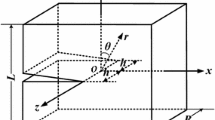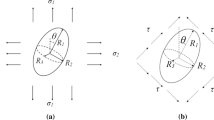Abstract
This study explores applications of three-parameter Weibull stress models to predict cleavage fracture behavior in ferritic structural steels tested in the transition region. The work emphasizes the role of the threshold parameters (σth and σw − min) in cleavage fracture predictions of a surface crack specimen loaded predominantly in tension for an A515-70 pressure vessel steel. A recently proposed procedure based upon a toughness scaling methodology using a modified Weibull stress (σ* w) extends the calibration scheme for the Weibull modulus, m, to include the threshold parameters. The methodology is applied to calibrate the Weibull stress parameter for the tested material and then to predict the toughness distribution for the surface crack specimen. While the functional relationship between σ* w and m suggests a strong effect of the threshold stress, σth, on the calibrated m-parameter, the results show a remarkably weak dependence of fracture predictions on σth as does the dependence of fracture predictions on σw−min for this specimen.
Similar content being viewed by others
References
American Society for Testing and Materials (1998). Test Methods for the Determination of Reference Temperature, T0, for Ferritic Steels in the Transition Region, ASTM E-1921, Philadelphia.
Bakker, A. and Koers, R.W.J. (1991). Prediction of cleavage fracture events in the brittle-ductile transition region of a ferritic steel. In: Defect Assessment in Components – Fundamentals and Applications, ESIS/EG9 (Edited by Blauel and Schwalbe), Mechanical Engineering Publications, London, pp. 613–632.
Beremin, F.M. (1983). A local criterion for cleavage fracture of a nuclear pressure vessel steel. Metallurgical Transactions 14A, 2277–2287.
Gao, X., Dodds, R.H., Tregoning, R.L., Joyce, J.A. and Link, R.E. (1999). A Weibull stress model to predict cleavage fracture in plates containing surface cracks. Fatigue and Fracture of Engineering Materials and Structures 22, 481–494.
Gao, X., Ruggieri, C. and Dodds, R.H. (1998). Calibration of Weibull stress parameters using fracture toughness data. International Journal of Fracture 92, 175–200.
Hughes, T.J. (1980). Generalization of selective integration procedures to anisotropic and nonlinear media. International Journal for Numerical Methods in Engineering 15, 1413–1418.
Joyce, J.A. and Link, R.E. (1997). Ductile-to-brittle transition characterization using surface crack specimens loaded in combined tension and bending. In: Fatigue and Fracture Mechanics, Vol. 28, ASTM STP 1321, (Edited by J.H. Underwood et al.), American Society for Testing and Materials, Philadelphia, pp. 243–262.
Koppenhoefer, K., Gullerud, A., Ruggieri, C., Dodds, R. and Healy, B. (1994). WARP3D: Dynamic nonlinear analysis of solids using a preconditioned conjugate gradient software architecture. Structural Research Series (SRS) 596, UILU-ENG–94–2017, University of Illinois at Urbana-Champaign.
Mann, N.R., Schafer, R.E. and Singpurwalla, N.D. (1974). Methods for Statistical Analysis of Reliability and Life Data, Jonh Wiley and Sons, New York, NY.
Minami, F., Brückner-Foit, A., Munz, D. and Trolldenier, B. (1992). Estimation procedure for the Weibull oarameters used in the local approach. International Journal of Fracture 54, 197–210.
Moran, B. and Shih, C.F. (1987). A general treatment of crack tip contour integrals. International Journal of Fracture 35, 295–310.
Mudry, F. (1987). A local approach to cleavage fracture. Nuclear Engineering and Design 105, 65–76.
Press, W.H., Teukolsky, S.A., Vetterling, W.T. and Flannery, B.P. (1992). Numerical Recipes in FORTRAN: The Art of Scientific Computing, 2nd ed., Cambridge University Press, Cambridge.
Ruggieri, C. (1998). Probabilistic treatment of brittle fracture using two failure models. Probabilistic Engineering Mechanics 13, 309–319.
Ruggieri, C. and Dodds, R.H. (1996). A transferability model for brittle fracture including constraint and ductile tearing effects: a probabilistic approach. International Journal of Fracture 79, 309–340.
Ruggieri, C. and Dodds, R.H. (1996). Probabilistic modeling of brittle fracture including 3-D effects on constraint loss and ductile tearing. Journal de Physique 61, 353–362.
Ruggieri, C. and Dodds, R.H. (1997). WSTRESS Release 1.0: numerical computation of probabilistic fracture parameters for 3-D cracked solids. BT-PNV-30 (Technical Report), EPUSP, University of São Paulo.
Ruggieri, C., Dodds, R.H. and Wallin, K. (1998). Constraints effects on reference temperature, T 0, for ferritic steels in the transition region. Engineering Fracture Mechanics 60, 19–36.
Ruggieri, C., Gao, X. and Dodds, R.H. (2001). Transferability of elastic-plastic fracture toughness using the Weibull stress approach: significance of parameter calibration. Engineering Fracture Mechanics 67, 101–117.
Sorem, W.A., Dodds, R.H. and Rolfe, S.T. (1991). Effects of crack depth on elastic plastic fracture toughness. International Journal of Fracture 47, 105–126.
Tregoning, R. (1998). Unpublished Experimental Data.
Wallin, K. (1984). The scatter in KIc results. Engineering Fracture Mechanics 19, 1085–1093.
Wallin, K. (1991). Fracture toughness transition curve shape for ferritic structural steels. In: Fracture of Engineering Materials & Structures (Edited by S.T. Teoh and K.H. Lee), Elsevier Applied Science, Amsterdam, pp. 83–88.
Wallin, K. (1993). Irradiation damage effects on the fracture toughness transition curve shape for reactor pressure vessel steels. International Journal of Pressure Vessels and Piping 55, 61–79.
Wallin, K., Saario, T. and Torronen, K. (1984). Statistical model for carbide induced brittle fracture in steel. Metal Science 18, 13–16.
Weibull, W. (1939). The phenomenon of rupture in solids. Ingeniors Vetenskaps Akademien, Handlingar 153, p.55.
Wiesner, C.S. and Goldthorpe, M.R. (1996). The effect of temperature and specimen geometry on the parameters of the local approach to cleavage fracture. In: International Conference on Local Approach to Fracture (MECAMAT 96), Fontainebleau, France, pp. C6–295–304.
Williams, M.L. (1957). On the stress distribution at the base of a stationary crack. Journal of Applied Mechanics 24, 109–114.
Xia, L. and Shih, C.F. (1996). Ductile crack growth. III. Transition to cleavage fracture incorporating statistics. Journal of Mechanics and Physics of Solids 44, 603–639.
Author information
Authors and Affiliations
Rights and permissions
About this article
Cite this article
Ruggieri, C. Influence of threshold parameters on cleavage fracture predictions using the Weibull stress model. International Journal of Fracture 110, 281–304 (2001). https://doi.org/10.1023/A:1010801603304
Issue Date:
DOI: https://doi.org/10.1023/A:1010801603304




